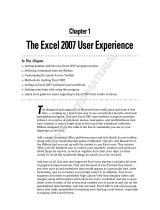Organizations the world over rely on information to make sound decisions regarding all manner of affairs. But with the amount
of available data growing on a daily basis, the ability to make sense of all of that data is becoming more and more challenging.
Fortunately, this is where the power of Microsoft Excel can help.
Excel can help you organize, calculate, analyze, revise, update, and present your data in ways that will help the decision
makers in your organization steer you in the right direction. It will also make these tasks much easier for you to accomplish, and
in much less time, than if you used traditional pen-and-paper methods or non-specialized software. This course aims to provide
you with a foundation for Excel knowledge and skills, which you can build upon to eventually become an expert in data
manipulation.
Note: Most Office users perform the majority of their daily tasks using the desktop version of the Office software, so that is the
focus of this training. The course material will also enable you to access and effectively utilize many web-based resources
provided with your Microsoft 365 subscription. This includes brief coverage of key skills for using Excel for the Web and
OneDrive. Helpful notes throughout the material alert you to cases where the online version of the application may function
differently from the primary, desktop version.
This course is intended for students who wish to gain the foundational understanding of Excel that is necessary to create and
work with electronic spreadsheets.
To ensure your success, you should have end-user skills with any current version of Windows, including being able to start and
close applications, navigate basic file structures, manage files and folders, and access websites using a web browser. To obtain
this level of skills and knowledge, you can take the following Logical Operations course:
− Using Microsoft Windows 10 (Second Edition)
By the end of this course, users will know how to:
− Familiarize yourself with Excel's layout, its various parts, its commands, and its terminology.
− Outline Excel's abilities to quickly, efficiently, and accurately calculate data.
− Update worksheets without throwing away all of the valuable work you've already done.
− Format a worksheet and organize your data.
− Print workbooks.
− Manage the overall structure of your workbooks.
Lesson 1: Getting Started with
Excel
− Topic A: Navigate the Excel
User Interface
− Topic B: Use Excel
Commands
− Topic C: Create and Save a
Basic Workbook
− Topic D: Navigate in Excel for
the Web
− Topic E: Enter Cell Data
Lesson 2: Performing
Calculations
− Topic A: Create Worksheet
Formulas
− Topic B: Insert Functions
− Topic C: Reuse Formulas and
Functions
Lesson 3: Modifying a
Worksheet
− Topic A: Adjust Cells,
Columns, and Rows
− Topic B: Search for and
Replace Data
− Topic C: Use Proofing and
Research Tools
Lesson 4: Formatting a
Worksheet
− Topic A: Apply Text Formats
− Topic B: Apply Number
Formats
− Topic C: Align Cell Contents








